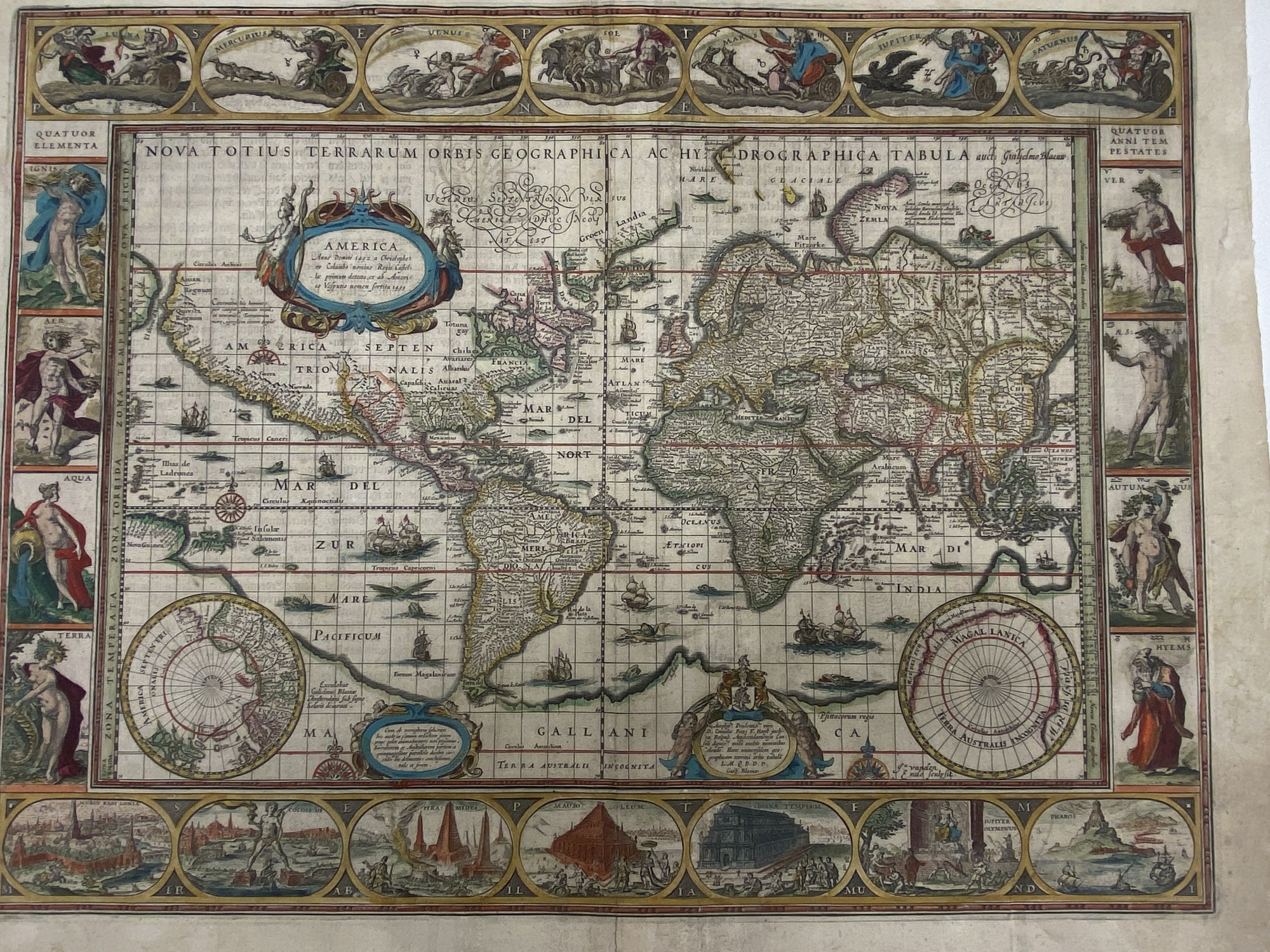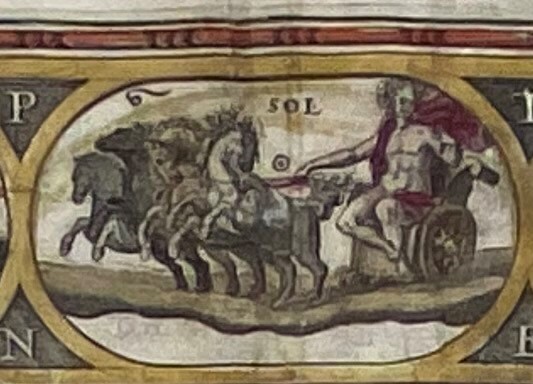The Art of Cartography: Cartes-à-figures
Illustrating Classical Antiquity
The Nova Totius Terrarum Orbis Geographica Ac Hydrographica Tabula or “A New Geographic and Hydrographic Depiction of All the Lands of the World” was composed by Willem Blaeu in Amsterdam in 1630. The map exemplifies the knowledge at the time through the illustration of the five discovered planets as well as the standard 17th century misconceptions in geography. The rectangular shape and lines of latitude and longitude were reflective of Blaeu’s incorporation of Gerhardus Mercator’s world projection released in 1569. Blaeu’s map contains numerous inaccuracies of the world, based on Meractor’s projection. To note, the elongated northwest coast of America does not exist and neither does the strait that connects South America to Antartica. Despite the geographical misconceptions, the Nova Totius Terrarum Orbis Geographica Ac Hydrographica Tabula was Blaeu’s standard map and was included in all his atlases until 1662.
Dutch cartes-à-figures are typically represented in human or animal forms of natural events, spiritual or celestial observations, and even places. The Nova Totius Terrarum Orbis Geographica ac Hydographica Tabula features the planets in proper alignment, the four seasons, the four elements, and even the seven ancient wonders of the world. These illustrations are elaborately designed with details and adorned with colorants. Blaeu was a prominent publisher of decorative borders and vignettes and stylized the era with his cartes-à-figures.
A Note About Copyright and the Art Movements of the Renaissance, Baroque, and Mannerist Period
Blaeu’s Nova Totius Terrarum Orbis Geographica Ac Hydrographica Tabula draws inspiration for its illustrations and cartes-à-figures from two Dutch painters and printmakers: Maarten Van Heemskerck and Hendrick Goltzius. It is more accurate to say that Blaeu copied the prints and paintings of these artists. In fact, many of the cartes-à-figures are mirror images of these artist's work. The illustrations of the planets and the seven wonders of the ancient world are drawn nearly identical to Marteen Van Heenskercks’s prints from 1568 and 1572 respectively. The four elements and the four seasons are replicas from Hendrick Goltizius’s prints from 1586 and 1589. Creating illustrations based on another artist's work was nothing new, everyone was coping someone. In the age of the Early Modern Period, there was no such thing as copyright laws. Copyright laws only came into existence at the end of the 18th century.
During the 16th and 17th centuries, the art world was transitioning from the late Renaissance period into Mannerism which would later continue into the Baroque period. The Renaissance era was defined by a rebirth and invigorated interest in the classical Greco-Roman era. Artists used illusionistic painting techniques to increase depth and natural realism. Additionally, there was an emergence in individual figures and creating symbolic representations. Contrapposto was an important development during the Renaissance for it emphasized the human body, realistic proportions, and the appearance it created in alluding to current and future movement. Mannerism acted as the bridge that connected the idealization found in the Renaissance to the dramatic nature of the Baroque period. Mannerist art typically produced exaggerated emotions, human figures in contorted poses, and unusual perspectives. The Mannerism art style wanted to parody the realism from the Renaissance era by depicting the imaginary of the spiritual and unperceivable world. These illusionistic paintings and style led to the Baroque period a time of illustrating biblical, mythological, and allegorical figures. Chiaroscuro was a prominent art style during the Baroque era for its illusionary abilities to create three dimensional forms from contrasting light and shadows. Chiaroscuro created the dramatic effect synonymous with Baroque art. Movement and allegorical representations of Greco-Roman figures created during the Renaissance period, and exaggerated realism and depicted imaginary beings reflects the mannerist period, so does the illusionary shadows of the Baroque period, and all styles are captured in Blaeu’s Nova Totius Terrarum Orbis Geographica Ac Hydrographica Tabula.
The Roman Deities
Featured along the top border are cartes-à-figures of the seven known “planets” at the time, Mercury (Mercurius), Venus, Mars (Mar), Jupiter, and Saturn (Saturnus), and the sun (Sol) and the moon (Luna). These celestial illustrations are represented in their respective Roman anthropomorphic deity stylized with their emblematic objects and symbols. Planetary and astrological observation was an ongoing study in Europe during the 16th and 17th centuries. Willem Blaeu began his career in cartography producing celestial globes with representations of the planets and the zodiac. Therefore, it is no surprise that these celestial bodies were featured in the Nova Totius Terrarum Orbis Geographica Ac Hydrographica Tabula as homage.
In the far-left corner sits Luna, the Roman embodiment of the moon. Luna is represented as a female and her counterpart is the sun (Sol). Luna is depicted alongside Proserpina and Hecate who pull the two-yoke chariot. Sometimes Luna is referred to as the “two-horned-queen" which is evident here in Blaeu’s illustration of her two-pronged crown. Lastly, the astronomical symbols of Luna are present, the crescent moon situated between Luna and the other goddesses, and the zodiac sign Cancer.
In contrast, the Roman deity Sol is Luna’s counterpart and is situated in the middle of the top border. As a solar deity, Sol represents the sun depicted in a masculine form and rides a racing chariot pulled by four horses. Sol is also depicted wearing a crown of sunrays and alongside his astrological symbols of the sun, presented as a closed circle circumscribed by a larger ring, and the zodiac sign Leo.
The Four Elements
Featured on the left-hand side of the map are the four elements, Fire (Ignis), Air (Aer), Water (Aqua), and Earth (Terra). The elements are depicted as both men and women in semi-nude form. The decision to represent the four elements as either male of female comes from the Humoral Theory that women were cold, and moist beings while men were hot and dry, indicating their perfection of their bodies. An interesting characteristic of the female representations of the elements of Aqua and Terra are that they are looking away, a common design by many artists of the Renaissance and Baroque period as an invitation to gaze upon their nude bodies. This idea is coined the ‘male gaze’ and expresses the male interest in exploring their erotic curiosities about the female body.
Click on the images below to read more about the four elements.
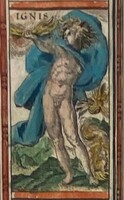
Ignis, the Latin term for fire, is represented as a male figure shrouded in a blue cloak. The allegorical figure of Ignis is holding flames in his outstretched right hand while his left holds what appears to be the sun. His posture and stance create contrast and shadows between his body and cloak. This stylized spiral movement is commonly illustrated in Baroque art. Additionally, near his right foot sits a salamander slithering through flames, a creature common in symbolizing the element of fire. Salamanders are associated with the fire element for ancient folklore created imaginary tales about their ability to survive flames.
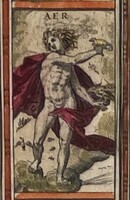
Aer, the element of air, is illustrated as an idealized muscular man with a flowing red cloak. Surrounding the allegorical representation of air are birds in flight and at rest. Aer holds in his outstretched right hand a lizard and in his left a bird at rest. Like Ignis, Aer’s body is illustrated in a contorted spiral state and posed in a Renaissance style of contrapposto. The billowing clouds that encircle the figure are common in pictural representations of the element Aer.
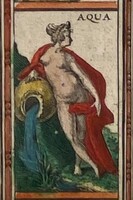
The element of water, or Aqua as is seen here, is represented as a woman. The figure shrouds her backside with a flowing red cloak. Aqua’s body is relaxed, and her head turned, this posture invites the viewer to gaze upon her figure. The dramatic pose and shadows of the illustration reflect the Baroque art movement’s fascination with how the eye perceives light. Situated to her right, is an amphora vase flowing water, creating a small stream below her feet.
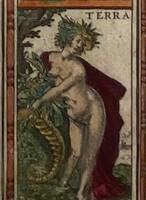
The fourth and final figure in this paneled border is of Terra, or the element of Earth. Like Aqua, her red cloak is behind her, her figure is nude, and her posture is enticing the male gaze. The illustrated figure is depicted in exaggerated contrapposto and reaching across her body, creating not only shadows but movement and action. Terra wears a headdress of leaves, perhaps indicating her connection or status as Mother Earth. Additionally, the cornucopia next to her side represents an abundant harvest as it is depicted full of leafy fruits.
The Four Seasons
The cartes-à-figures on the right-hand side illustrate the Quatuor Anni Tempestates or the four seasons of the year. Each figure is in the act of something representative of the season for which they embody. For example, Autumnus holds plump grapes an indicator of the harvesting of fruit during the season. The four seasons also are representative of the cycle of life, while old man winter destroys and kills the harvest autumn brings, youthful spring acts as a reminder of new beginnings for new life and crops. Each encompasses its own set of three zodiac signs that characterize the changing of the seasons.
Click on the images below to read more about the four seasons.
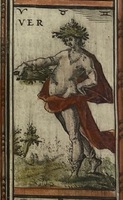
The first figure is of Ver: spring. Ver is illustrated as a semi-nude, androgynous stylized man wearing a headdress of flowers and carrying what appears to be a collection of leafy branches. The headdress symbolizes the season as a time of blooming flowers and rebirth. Additionally, Ver sports decorative arm bands, a beaded necklace, and ankle bangles. The figure is depicted in contrapposto as he has an exaggerated stance with an outstretched hip bearing his weight on his left leg. This posture is a nod to Mannerist art period. Also, above the figure are the three zodiac signs that appear during the season: Aries, Taurus, and Gemini.
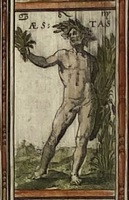
Below Ver, is Aestas or summer depicted as a man in full heroic classical nudity. Here the allegorical representation of summer is clutching stalks of wheat by his waist and holding loose grains in his outstretched right hand, while wearing a crown of yellow corn leaves. The figure, like Ver, favors his weight with his left leg and is posed in the Mannerist torsion. Unlike Ver, however, Aestas sports a full beard and his facial hair and physique are symbolic elements of the ideal age. This personification of summer depicts the bountiful harvest of wheat associated with the season. The zodiac signs that fall under Aestas are Cancer, Leo, and Virgo.
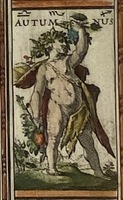
Autumnus, Latin for Autumn, is represented as a portly man holding a cluster of grapes above his head in his left-hand and with his right clutches freshly harvested fruit of what appears to be apples. Autumnus represents the season of harvest and celebration. The figure wears a loose yellow and red garment that crosses his torso and sports a crown of vines. In comparison to Ver and Aestas, Autumnus is representated as a middle aged man, gone is Ver’s feminine features and Aestas beard, both have been replaced by a stout figure’s protuberant belly. The grapes that Autumnus holds as well as his rounded figure, are allegorical tributes to the Roman god of wine, Bacchus. The three zodiac signs associated with Autumnus are Libra, Scorpio, and Sagittarius.
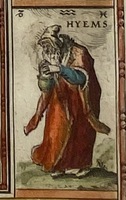
At the bottom of the panel sits Hyems (Latin for winter). Here, Hyems is personified by ‘old man winter’ himself, wrapped in thick fur garments and wearing a stocking cap over his white hair. Hyems holds a small steaming pot, or perhaps urn, to keep warm. Winter is evident in the background as there is a lack of greenery and the clouds above symbolize the brutal cold that is associated with winter. Additionally, his crouching posture and old age suggest nearby death, a reminder of nature’s cycle of life and death. The zodiac signs associated with winter are Capricorn, Aquarius, and Pisces.
The Wonders of the World
Situated on the bottom border are illustrations of the seven wonders of the ancient world. Coming off the heels of the Renaissance period of the 14th century, a renewed interest in the ancient Greco-Roman world contributed to Europeans illustrating these ancient sites. Many of these illustrations were based on poems and written accounts from ancient authors as most of the wonders of the ancient world were already extinct by the 17th century. Today, the only wonder of the ancient world that remains is the Great Pyramids of Giza.
The first illustration on the left is of the Hanging Gardens of Babylon illustrated from outside the gates of the kingdom. Adorning the city gates is lush greenery, although it is unknown whether this represents the hanging gardens. The tall coned building in the background represents the Tower of Babel, while in the foreground is a woman on horseback - prepared to strike a lion with bow and arrow.
The Colossus of Rhodes is illustrated as seminude muscular golden male statue towering over the Mandraki Harbor in Rhodes, Greece. The statue holds a torch in his outstretched right hand while the other carries a bow as he slings a quiver on his back filled with arrows. Notice the ship sailing beneath the statue sports the flag of the Dutch East India Company.
Situated near the middle of the border is the illustration of the Pyramids of Giza. Near the edge of the illustration stands a leading figure who sports a crown and scepter, representing a king. Also, seen near the base of the pyramids is a circular colosseum actively on fire producing flames and emitting smoke. Here, the pyramids are depicted as tall and thin, it is suggested that this misinterpreted shape stems from the study of obelisks.
The Mausoleum of Halicarnassus, a commissioned tomb by Artemesia for her late husband (and brother), Mausollos, the ruler of the Kingdom of Caria, is seen here illustrated in midconstruction. The depiction of the Mausoleum features a multi-tiered structure with statues and columns adorning the building. In the foreground is Artemesia herself, dressed in rich clothing, shaded by servants holding a large umbrella surveying the construction.
The Diana Templum, also known as the Temple of Artemis, is located in Ephesus or modern day Turkey. This three storied temple designed with many intricate columns, alcoves, and motifs is illustrated, similarly to the Mausoleum of Halicarnassus, in midconstruction. The figures near the right side of the border are conversing about the architect’s plans etched in tablet, while a nearby worker sculpts a column base.
The ancient wonder of the Statue of Jupiter at Olympia, also known as the Statue of Zeus, is depicted as a golden figure clasping a lightning bolt in one hand while the other holds a glowing orb. Also, resting below his left arm sits an eagle. In the foreground are multiple pairs of men wrestling, a common activity and sport featured in the ancient Olympic games. Near the left side of the border is a kneeling figure being crowned victorious with a laurel wreath.
Before it was called the lighthouse of Alexandria it was known in the ancient world as Pharos, seen here in Blaeu’s illustration. The Pharos of Alexandria is represented atop a voluminous island with many sailing ships entering the harbor. In the background sits a winding bridge connecting the lighthouse to the rest of the city of Alexandria.
